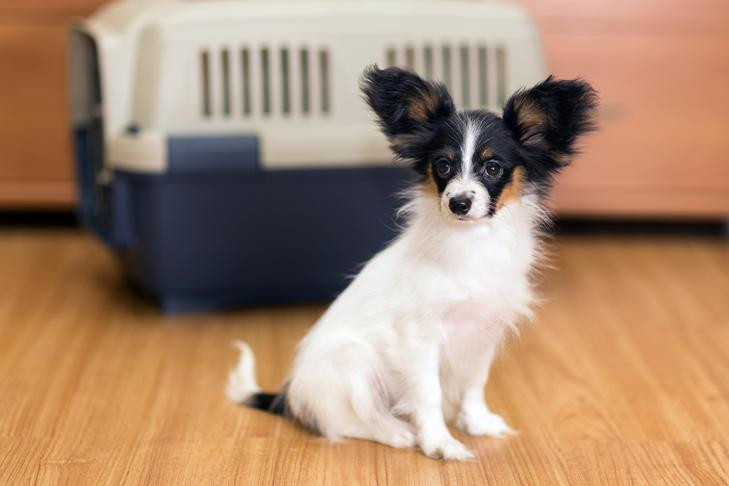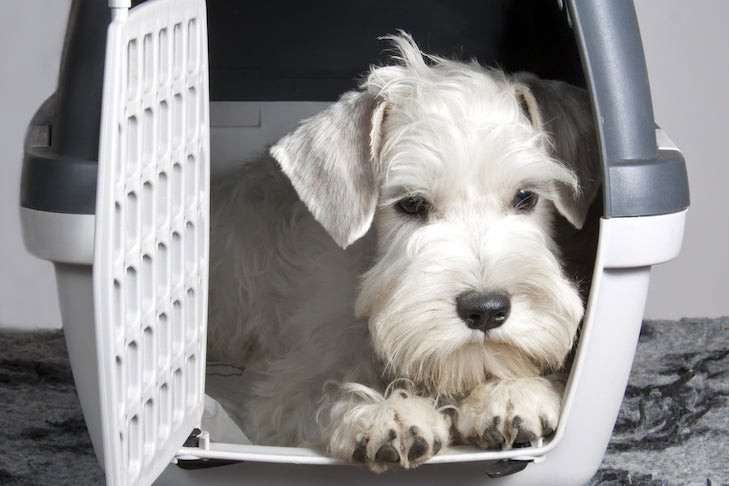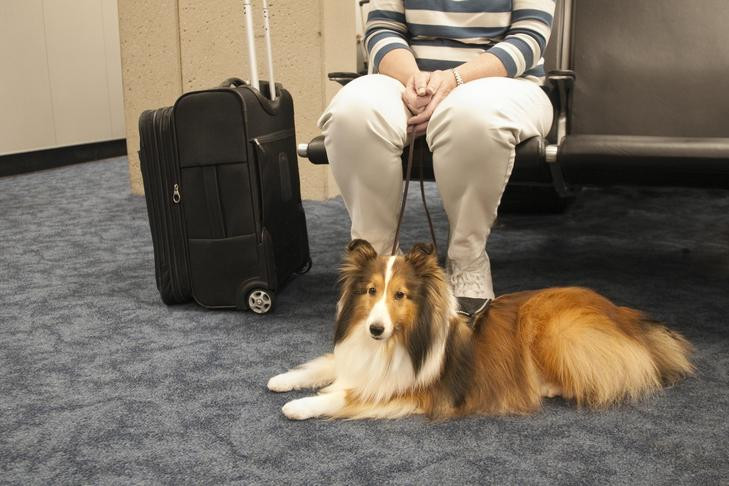Can You Fly With Small Dogs? Yes, you can fly with small dogs on many airlines, but preparation is key to ensuring a smooth and stress-free journey for both you and your furry friend. At flyermedia.net, we’ll walk you through everything you need to know, from airline policies to health requirements, making air travel with your canine companion a breeze. Planning well leads to enjoyable pet travel, reducing concerns about pet air transport while ensuring comfort.
1. Is Flying Safe For Your Dog?
Flying can be stressful for both humans and dogs. According to Dr. Jerry Klein, Chief Veterinary Officer for the American Kennel Club, the unfamiliar sounds, sights, and smells of airports and new destinations can be challenging for pets. Before you book that flight, consult with your veterinarian to ensure that air travel is safe for your dog’s specific health needs.
1.1. Health Considerations
Changes in diet and water during travel can impact a dog’s gastrointestinal health. Time-zone changes and travel upheaval could also lead to dehydration or disrupt medication schedules, which can be serious for dogs with conditions like diabetes. Talk to your vet about these potential risks and how to mitigate them.
 Papillon sitting indoors with a traveling crate in the background.
Papillon sitting indoors with a traveling crate in the background.
1.2. American Kennel Club Recommendations
The American Kennel Club (AKC) emphasizes that air travel can be particularly stressful for dogs. Discuss your travel plans with your veterinarian, especially if your dog has pre-existing health conditions, anxiety, or a sensitive stomach. They can provide personalized advice and recommend strategies to make the journey easier for your pet.
2. Preparing for Air Travel with Your Small Dog
Proper preparation is crucial when flying with your dog. This involves understanding travel restrictions, quarantine requirements, and health documentation.
2.1. Confirming Travel Policies
Verify if your dog can travel with you to your destination. Check for any quarantine, vaccination, or other restrictions for dogs entering that area. The AKC provides a list of state-by-state travel requirements, and additional rules may apply for international travel.
2.2. Booking Direct Flights
Whenever possible, book direct flights to minimize stress on your dog. If you’re traveling in the summer, opt for early morning or evening flights. In winter, midday flights are best to avoid extreme temperatures. Note that airlines often restrict cargo travel for pets during periods of extreme heat or cold.
2.3. Centers for Disease Control and Prevention (CDC) Guidelines
As of August 2024, the CDC has implemented new guidelines for dogs entering the U.S. If you’re importing a dog or returning from another country, you must submit a CDC-approved Dog Import Form online in advance. Dogs must be immunized against rabies, be at least 6 months old, and have an International Standards Organization standard microchip.
2.3.1. High-Risk Countries
Dogs coming from a high-risk country also need a U.S. rabies vaccine certificate, a certification of foreign-issued rabies vaccination, or a certification of foreign rabies vaccination, plus a microchip form. Quarantine may be required upon arrival.
3. Essential Health Checklist Before Flying
Ensuring your dog is healthy enough to travel is paramount. Here’s a health checklist to follow:
3.1. Veterinary Appointment
Schedule a vet appointment for a check-up. While many domestic flights don’t require a signed health certificate, it’s best to ensure your dog is healthy and up-to-date on vaccinations. Your vet can also provide an updated rabies certificate.
3.2. Medication Preparation
Pack enough prescription medications for the duration of your trip. Don’t forget preventative flea and tick medications.
3.3. Prescription Diets
If your dog requires a specialized diet, bring an ample supply of their food. Finding specific prescription diets while traveling can be challenging.
 Sealyham Terrier laying down in a travel crate.
Sealyham Terrier laying down in a travel crate.
4. What to Pack When Flying With Your Dog
Packing the right items ensures your dog’s comfort and safety during the flight.
4.1. Necessary Documents
Bring proof of vaccinations and health certificates, even if not required. These documents can be useful in case of unexpected situations. Always check entry requirements, including quarantine information, for your destination.
4.2. Airline-Approved Carrier
Ensure your carrier meets the airline’s size requirements. Carriers should be waterproof and provide ample space for your dog to sit, stand, lie down, and turn around.
4.3. Essential Supplies
Pack a portable water bowl, a portable food bowl, a small amount of food, treats, poop bags, and pet wipes. These items are crucial for maintaining your dog’s hygiene and comfort during travel.
4.4. Comfort Items
Include a chew toy to help your dog relax during takeoff and landing. The pressure changes can be uncomfortable, and chewing helps alleviate anxiety.
5. Preparing Your Dog for the Flight Experience
Familiarizing your dog with the crate before flying can significantly improve their travel experience.
5.1. Crate Familiarization
Introduce your dog to their crate early. Make it a safe and comfortable space with praise and treats. Encourage them to explore the crate at home.
5.2. Exposure to Public Places
Take your dog to crowded, dog-friendly places like bus stations and pet stores. This helps them acclimate to the sights and sounds of an airport.
5.3. Behavior Training
Airlines require dogs to be well-behaved, meaning no excessive barking, growling, or aggressive behavior. Consider training your dog and earning a Canine Good Citizen (CGC) title. These skills, such as walking through crowds and behaving politely around other dogs, will be invaluable.
5.4. Simulated Airplane Environment
Some trainers simulate an airplane environment with rows of chairs to teach dogs how to sit under a seat in a carrier. This specific training can be extremely beneficial.
6. Navigating the Airport With Your Dog
Knowing what to expect at the airport can help streamline the process.
6.1. Cargo Check-In
If your dog is flying via cargo, check them in with the airline upon arrival. Airline staff will handle getting your dog’s crate onto the plane and off at your destination.
6.2. TSA Screening
If your dog is traveling in the cabin, you’ll need to go through TSA screening. Your dog will need to come out of their carrier, walk through the full-body scanner, and TSA personnel will screen the carrier. They may also inspect your dog’s collar, harness, and leash.
6.3. Pet Relief Areas
Most airports have pet relief areas. Take advantage of these spaces to allow your dog to relieve themselves before the flight.
6.4. Pre-Boarding Activities
While waiting to board, you might be able to take your dog out of their carrier to stretch their legs, but always adhere to airport rules.
7. Managing Your Dog During the Flight
During the flight, your dog will need to remain in their carrier. Provide comfort and reassurance.
7.1. Carrier Requirement
Dogs are not allowed to sit on their owner’s lap during the flight. Ensure your dog stays comfortably inside their carrier.
7.2. Comfort Techniques
Offering a chew toy can comfort your dog during turbulent or noisy parts of the flight. Chewing helps to relax them and adjust to pressure changes.
8. Airline-by-Airline Guide for Flying With Small Dogs
Each airline has specific policies regarding pet travel. It’s crucial to contact the airline before booking to ensure there is space for your dog and to confirm any guidelines.
8.1. Alaska Airlines
Health and vaccine requirements: Not required for cabin travel, but dogs must be healthy. Cargo travel requires a health certificate within 10 days of the flight and 30 days of the return.
Are dogs allowed in the cabin? Yes, in an approved carrier under the seat.
Are there other restrictions on dogs in the cabin? First-class cabins allow three pet carriers, and the main cabin allows eight. For international flights or flights to Hawaii, dogs are only permitted in the cabin.
Are dogs allowed in cargo? Yes, dogs must be at least 8 weeks old and weaned.
Are there other restrictions on dogs in cargo? Dogs and crates cannot exceed 150 pounds combined. Dogs must be comfortable in their crates.
Is there a fee to travel with your dog? $100 per pet for cabin or cargo travel.
 Shetland Sheepdog service dog laying next to its owner at the airport.
Shetland Sheepdog service dog laying next to its owner at the airport.
8.2. American Airlines
Health and vaccine requirements: Cargo travel requires a signed health certificate within 20 days of the flight. Cabin travel does not require a health certificate.
Are dogs allowed in the cabin? Yes, in an approved carrier under the seat on flights up to 11 hours and 30 minutes.
Are there other restrictions on dogs in the cabin? A maximum of five to seven pets are allowed per flight, depending on the plane.
Are dogs allowed in cargo? Only permitted for active-duty U.S. Military and U.S. State Department personnel on official orders.
Is there a fee to travel with your dog? $150 per carrier for cabin travel. Cargo fees vary by destination.
8.3. Delta
Health and vaccine requirements: Health certificates aren’t required for cabin travel. Cargo travel requires a current health certificate within 10 days of the trip.
Are dogs allowed in the cabin? Yes, in a carrier that fits under the seat with ventilation on three sides (domestic) or four sides (international).
Are there other restrictions on dogs in the cabin? Dogs must be at least 8 weeks old for domestic flights and 16 weeks old (to the U.S.) or 15 weeks old (to Europe) for international flights.
Are dogs allowed in cargo? Yes, the carrier must allow the dog to sit, stand, lie down, and turn around comfortably and comply with International Air Transport Association regulations.
Is there a fee to travel with your dog? $95 each way for domestic flights and $200 for international flights.
8.4. Frontier
Health and vaccine requirements: No health certificate requirements, but specific destinations may require them.
Are dogs allowed in the cabin? Yes, dogs at least 8 weeks old are allowed on domestic flights and flights to/from the Dominican Republic and Mexico.
Are there other restrictions on dogs in the cabin? Dogs must be able to stand, turn around, and lie down comfortably in a soft-sided carrier under the seat.
Are dogs allowed in cargo? No.
Is there a fee to travel with your dog? $99 each way.
8.5. Hawaiian Airlines
Health and vaccine requirements: Health certificates are required for flights between Hawaii and the U.S. mainland, dated within 14 days of arrival. Contact the Hawaii Department of Agriculture for quarantine and vaccine requirements.
Are dogs allowed in the cabin? Yes, on certain flights.
Are there other restrictions on dogs in the cabin? Permitted on interisland flights and flights between the mainland and Hawaii. The combined weight of pet and carrier must be under 25 pounds.
Are dogs allowed in cargo? Yes, but the weight of the pet and carrier must not exceed 70 pounds.
Are there other restrictions on dogs in cargo? Cargo travel is restricted on most flights between April 15 and October 15 and when temperatures are below 20F or above 85F. No cargo travel on international flights.
Is there a fee to travel with your dog? $35 for flights within Hawaii and $125 for flights between Hawaii and the mainland.
8.6. JetBlue
Health and vaccine requirements: Dogs must have all required vaccines and documentation for the destination.
Are dogs allowed in the cabin? Yes, dogs under 20 pounds can travel in carriers in the cabin.
Are there other restrictions on dogs in the cabin? The combined weight of the dog and carrier must not exceed 20 pounds.
Are dogs allowed in cargo? No.
Is there a fee to travel with your dog? $125 per flight.
8.7. Southwest Airlines
Health and vaccine requirements: Passengers must comply with all vaccination and health certificate requirements of their destination.
Are dogs allowed in the cabin? Yes, for domestic flights only.
Are there other restrictions on dogs in the cabin? In-cabin pets are accepted on a first-come, first-serve basis, with a capacity of six pets per flight. Disruptive behavior can lead to denial of boarding.
Are dogs allowed in cargo? No.
Is there a fee to travel with your dog? $125 per pet carrier for U.S. Mainland flights and $35 per pet carrier between Hawaiian Islands.
8.8. Spirit
Health and vaccine requirements: Health certificates are not required except for flights to the U.S. Virgin Islands. Proof of rabies vaccination is required for flights to Puerto Rico.
Are dogs allowed in the cabin? Yes, dogs at least 8 weeks old are permitted on domestic flights. No pets on international flights.
Are there other restrictions on dogs in the cabin? One pet carrier per passenger, with up to two dogs inside if they fit appropriately. The combined weight must not exceed 40 pounds.
Are dogs allowed in cargo? No.
Is there a fee to travel with your dog? $125 per flight.
8.9. United
Health and vaccine requirements: Health certificates are encouraged but not required for domestic flights. Proof of rabies vaccinations and health certificates are required for international flights.
Are dogs allowed in the cabin? Yes, dogs at least 2 months old are permitted on domestic flights and 4 months old for international flights.
Are there other restrictions on dogs in the cabin? Restrictions on the number of pets in the cabin depend on the aircraft, with some allowing up to two pets and others up to six.
Are dogs allowed in cargo? No.
Is there a fee to travel with your dog? $125 per flight. An additional $125 fee applies for layovers longer than four hours for domestic flights or 24 hours for international flights.
9. Frequently Asked Questions (FAQ) About Flying With Small Dogs
9.1. What is the best way to prepare my small dog for a flight?
Begin by familiarizing your dog with their carrier. Make it a comfortable space with praise and treats, and gradually increase the time they spend inside. Expose them to new environments and sounds to reduce anxiety during travel.
9.2. Are there any specific health requirements for flying with my dog?
While health certificates may not always be mandatory for domestic flights, it’s wise to consult your vet for a check-up to confirm your dog’s fitness for travel and update any necessary vaccinations. International flights usually require a health certificate and proof of rabies vaccination.
9.3. What size carrier is appropriate for my small dog when flying?
The carrier should be large enough for your dog to stand, turn around, lie down, and sit comfortably. Ensure it meets the airline’s size restrictions for under-seat storage.
9.4. How can I minimize stress for my dog during the flight?
Provide familiar items like a favorite blanket or toy. Use calming aids recommended by your vet, and ensure they have access to water. During the flight, speak to them in a soothing voice and offer occasional treats if allowed.
9.5. Can I give my dog a sedative before the flight?
Consult with your veterinarian before administering any sedatives. While they might seem helpful, they can sometimes have adverse effects, especially at high altitudes.
9.6. What do I do if my dog gets anxious or sick during the flight?
Stay calm and reassure your dog. If they show signs of sickness, use pet wipes to clean them. Contact a flight attendant if the situation escalates.
9.7. Are there any dog breeds that are not allowed to fly?
Some airlines have restrictions on brachycephalic (short-nosed) breeds like Bulldogs and Pugs due to their increased risk of respiratory issues during air travel. Always check with your airline.
9.8. How early should I arrive at the airport when flying with my dog?
Arrive at least 2-3 hours before your flight to allow ample time for check-in, security, and any necessary pet relief breaks.
9.9. What happens if my dog barks excessively during the flight?
Airlines require dogs to be well-behaved. Excessive barking can lead to issues, so ensure your dog is trained and comfortable. Use calming techniques and distractions to keep them quiet.
9.10. Can my emotional support animal fly for free?
As of 2021, emotional support animals are generally considered pets and are subject to the same fees and restrictions as other pets. Only trained service dogs are typically allowed to fly without a carrier and without fees.
10. Flyermedia.net: Your Comprehensive Aviation Resource
Navigating the complexities of flying with small dogs requires careful planning and up-to-date information. At flyermedia.net, we provide a wealth of resources for aviation enthusiasts, including:
- Flight School Information: Find reputable flight schools in the USA.
- Aviation News: Stay informed about the latest industry updates.
- Career Opportunities: Discover various career paths in aviation.
Our website is designed to be your go-to source for all things aviation. Whether you’re seeking guidance on pet travel, pilot training, or industry news, flyermedia.net offers accurate, reliable, and engaging content.
11. Call to Action
Ready to make your aviation dreams a reality? Visit flyermedia.net today to explore flight school options, stay informed on aviation news, and discover exciting career opportunities in the USA. Whether you’re planning a trip with your small dog or pursuing a career in the skies, we have the resources you need to succeed.
Address: 600 S Clyde Morris Blvd, Daytona Beach, FL 32114, United States. Phone: +1 (386) 226-6000. Website: flyermedia.net.